JAPANESE KITCHEN KNIVES
Choosing a Gyuto: The Best Japanese Chef Knives
01.12.2014
No single kitchen tool defines a cook more than their chef’s knife. It’s the all purpose knife that is reached for most often. You could guess a bit about a cook’s habits from this one item. Is it sharp? Is it well maintained? Are there scratches from countless sharpenings? Is it kept with an immaculate mirror polish or are there evolving patterns of black, blue, and purple patina building up? Choosing a japanese chef’s knife is a very personal decision, I don’t even like to gift them. There’s no perfect knife for everyone and you need to know a lot about their preferences to give a good fit. I’d rather gift end grain cutting boards, sharpening stones, and other accessories instead.
RECOMMENDED: THE BEST JAPANESE CHEF KNIVES
[table id=5 /]
MY FAVORITE GYUTO: MIYABI BIRCHWOOD SG2 REVIEW
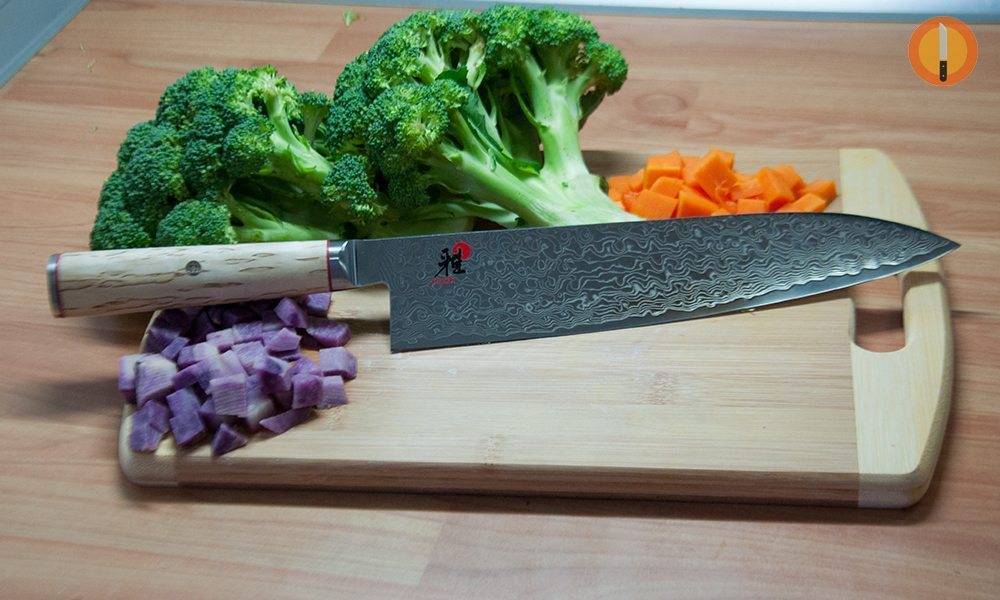
I’ve been using the Miyabi Birchwood SG2 for over 2 years now and I can tell you it’s a great knife. The first thing that you notice is the design of this gyuto: the flower damascus pattern is just stunning. The knife is 8 inches long and features a wooden handle that’s really comfortable.
[easyazon_link identifier=”B00BKEODHG” locale=”US” tag=”knifepla-20″]> Check out the Miyabi Birchwood on Amazon <[/easyazon_link]
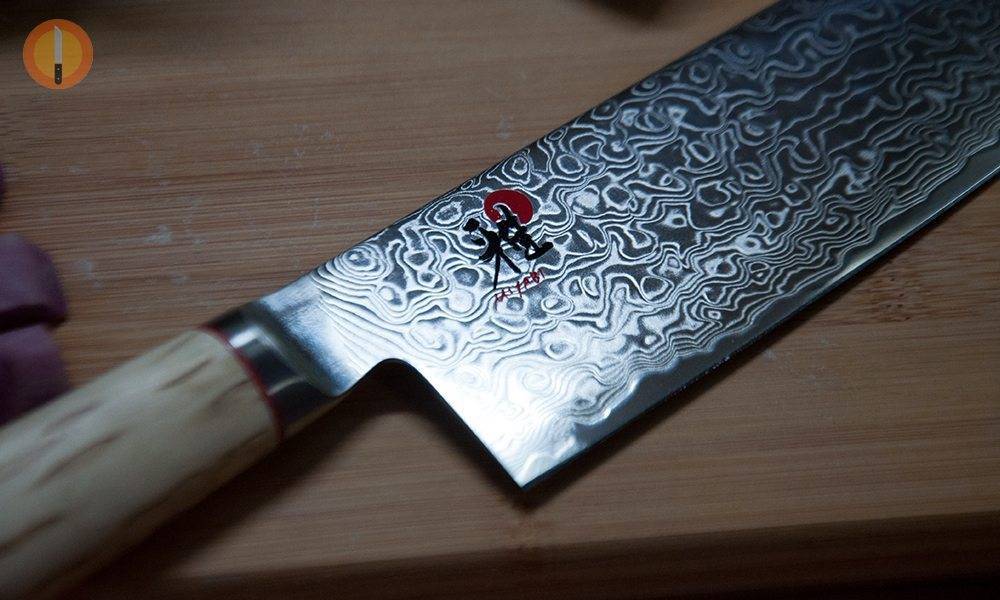
What do I use my Miyabi for? That’s a tough question. It’s such a versatile knife and I use it for a wide range of tasks in the kitchen. It’s the perfect knife for cutting, chopping, slicing and dicing vegetables. I also use it for fish and meat. It’s really the knife that I use more often in my kitchen.
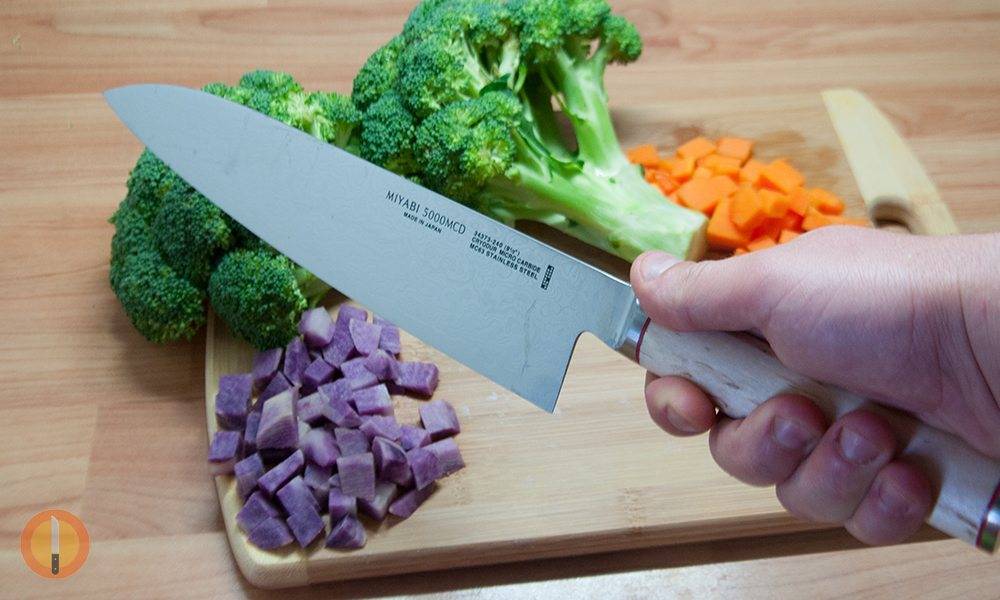
What I like the most is the handle. It feels good to use the Miyabi because the handle is balanced really well. It’s also safe to use with wet hands and doesn’t slip.
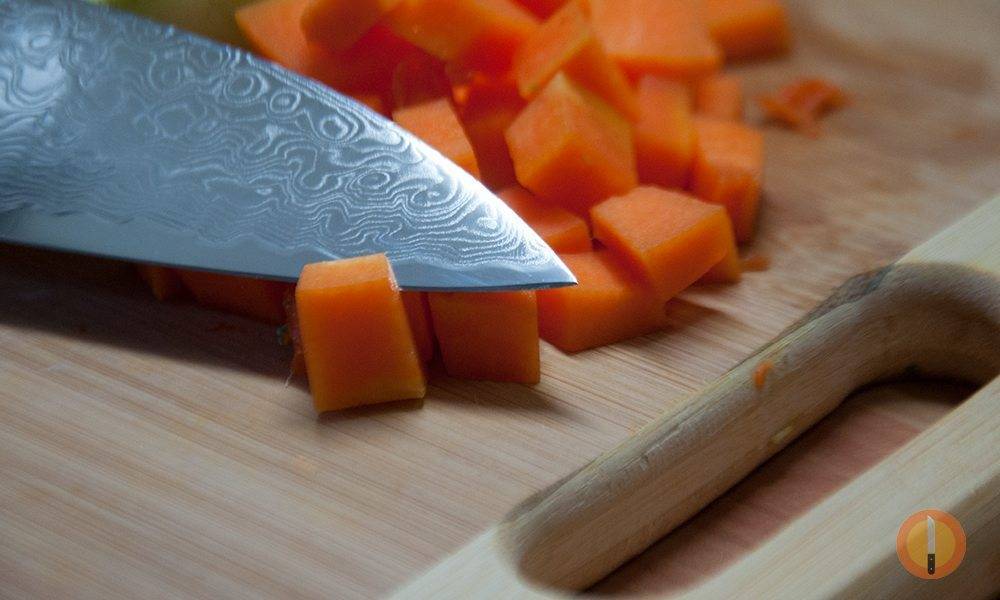
The blade is extremely sharp, right out of the box, and holds the edge for a long time. If you’re not used to sharp knives, you have to be careful at first: it will cut anything with no effort.
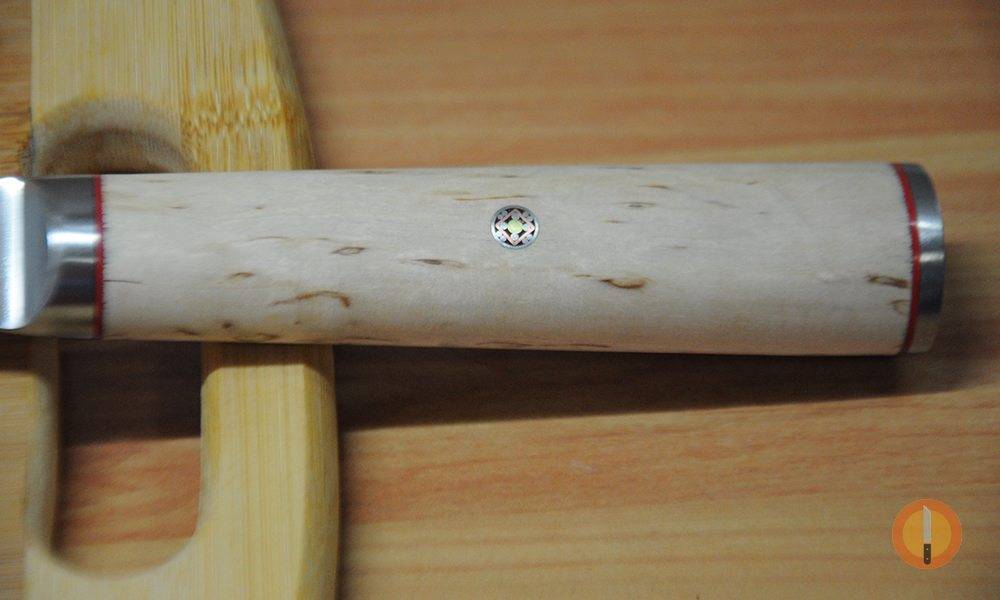
There are three things you’ll notice immediately: it’s thin, light and sharp. If I had to choose one Japanese chef knife to have in my kitchen, I’d choose the Miyabi Birchwood: It’s simply beautiful and cuts like butter.
KnifePlanet’s Video on Gyuto Knives. . .
![]()
[easyazon_link identifier=”B00BKEODHG” locale=”US” tag=”knifepla-20″]> Buy the Miyabi Birchwood on Amazon <[/easyazon_link]
ANOTHER GREAT KNIFE: YOSHIHIRO VG10 DAMASCUS

If you’re looking for a good japanese knife, look no further. The Yoshihiro is priced just right, and the quality is outstanding. What I like the most about it is the damascus cladding, which makes the knife look beautiful. Besides that, the knife comes very sharp and it’s ideal for any task in the kitchen, from chopping to dicing to cutting. It’s my knife of choice most of the times while cooking. The blade is easy to maintain sharp, and to re-sharpen when needed: it holds the sharp edge for a long time. I usually steel it once a week, and sharpen it on a 1000 grit stone when needed (alternatively, I have it sharpened by my local sharpening service).
[easyazon_link identifier=”B00D6DVTM6″ locale=”US” tag=”knifepla-20″]> Check out the Yoshihiro Knife on Amazon <[/easyazon_link]
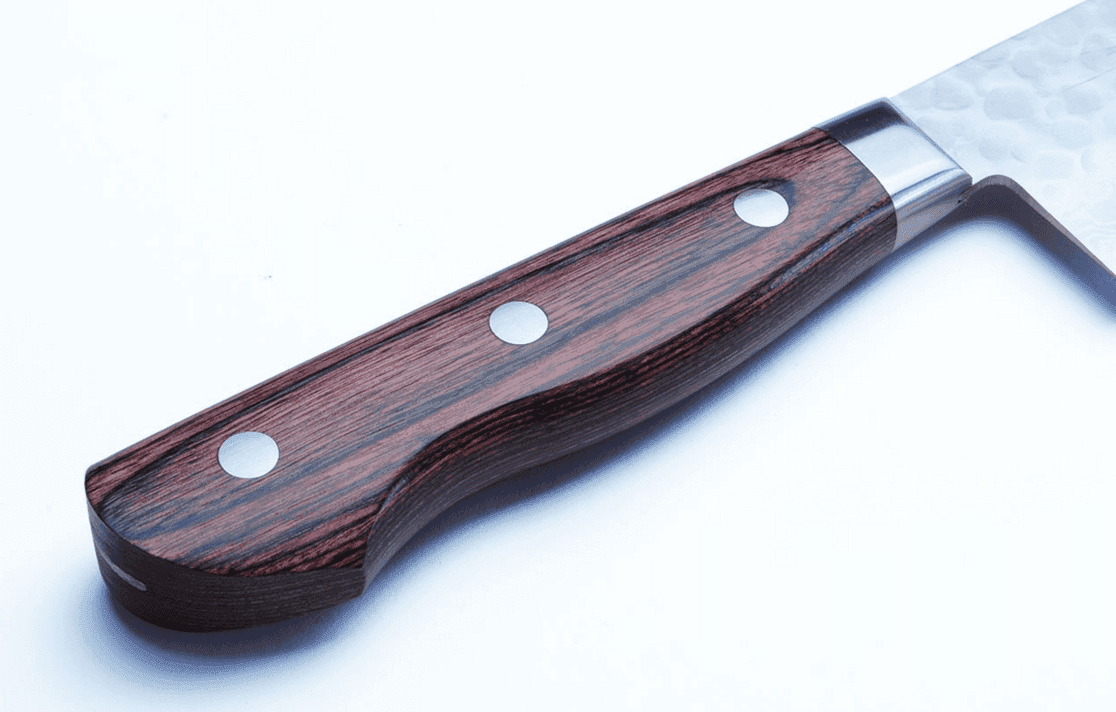
The wooden handle is really comfortable, it feels nice and balanced in your hand. I usually oil it from time to time to keep it shiny.
THE RISE OF JAPANESE-STYLE CHEF KNIVES
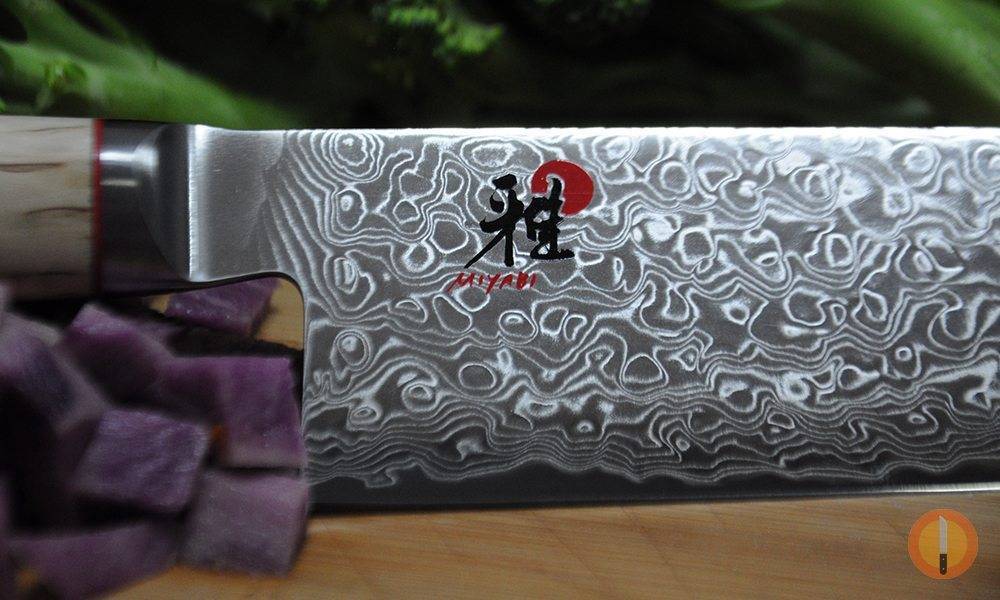
Cooks have been drawn more and more towards gyutos by Japanese makers (well mostly Japanese, there are other very talented makers doing this style now). A gyuto is simply the Japanese version of the western style chef’s knife. Unlike traditional Japanese knife styles like yanagiba, usuba, and deba, which are all single beveled, the gyuto is double beveled. The edge is more robust and there is less of a learning curve. Still, the harder steels used allow them to take sharper angles, with better edge retention, and simply outperform French or German chef’s knives.
With all this new demand, there are more options popping up than ever. 20 years ago or so your only option for a gyuto was Global. The amount of options from Japan now is kind of overwhelming. How is a person to choose? I’ve seen the advice of “go down to the store and see which one is comfortable in your hand”, which is frankly, terrible advice. Not only does the handle not tell me anything about performance, I don’t have a knife store nearby carrying what I’d want to try. I won’t give a blanket recommendation of an “ultimate” best gyuto ever, there are plenty of those articles around already. This article is to help you understand enough to shop for knives that you might not have a chance to hold in your hand. It’s more important to find the “right” knife for you than the “best” knife. You should match it to your preferences, cutting techniques, knife skill level, and sharpening skills.

7 THINGS TO CONSIDER WHEN SHOPPING FOR GYUTOS
1. PROFILE
The profile, simply, is what the knife looks like from the side. A german profile, like on a Wusthof, has a big rounded belly that is conducive to rock chopping, but then there’s less flat spot for push cutting:

The french profile has a more gradual belly and a larger flat spot. You can see this profile on any of the many makers of Sabatiers for example:

For this style profile, I would use the French technique that is something like a push cut, except you can point the tip downward and glide into the food. It’s easy on the edge, and nice and quiet. There are of course other schools of thought like push cutting or straight up and down chopping.
As far as gyutos go, you can have profiles anywhere from Shun, which is mostly German, to Takeda which is very flat, or anything in between. Nobody can tell you what is right or wrong, it’s just your preference. All I can say is to choose something that matches your technique, or be prepared to learn new cutting techniques.
2. CROSS SECTIONAL GEOMETRY
You might have guessed, but there’s more to a knife than just the cutting edge. For knife enthusiasts, one indicator of how the knife will perform is how thick or thin it is behind the edge. Imagine you’re cutting a hard vegetable like a carrot. A knife that is thin behind the edge will cut through cleanly. A knife that is thick behind the edge will cause it to wedge and break. A thick knife makes it more unpleasant to do something simple like dicing onions too!
If you look towards the tip of the knife from the handle, you’ll see the cross section (at the heel anyway). You can find all levels of thickness from extremely thin “lasers” up to heftier knives. Lasers might have poorer edge retention and be more prone to chipping. Your technique has to be even more perfect than usual; any torquing or twisting could cause chipping.
Here’s a few knives I have around to show you what I mean:
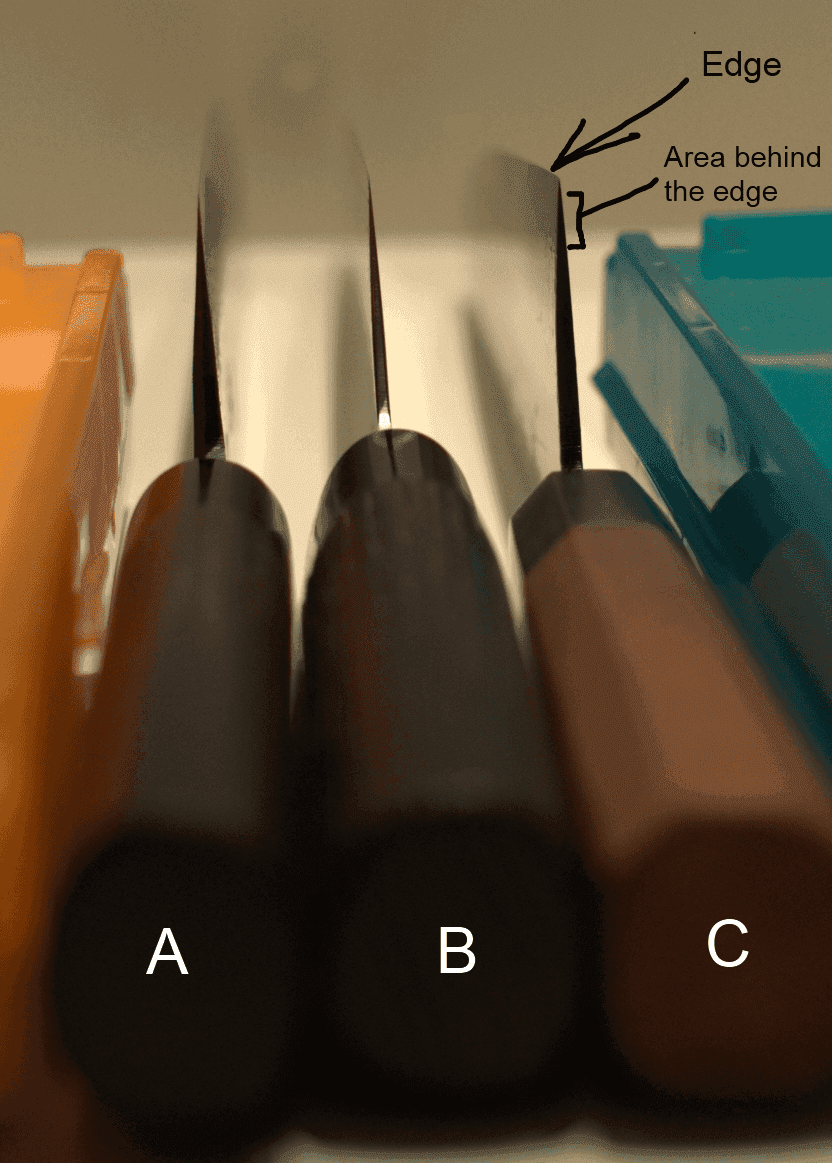
A picture from this perspective is called a “choil shot” on knife forums. I want to use this to illustrate what I’m talking about with thin and thick knives and point out the area behind the edge.
- A) Pretty thick knife at the spine (4.3mm), although it starts off thin for the first 1.5 cm directly behind the edge.
- B) Thin at the edge, behind it, and pretty much overall. Approaching ‘laser’ territory.
- C) I would call this about medium thickness. Knife A is actually thinner for the first cm or so behind the edge but then it gets wider dramatically.
3. ASYMMETRY

Gyutos are often asymmetric. This is a big difference between Japanese knives and western knives; this is something lefties especially need to look out for.
If it’s not labeled specially, it is made with a right handed user in mind. The cutting edge will have different angles on each side. To aid in food release, the right blade face is usually convexed and the left is more flat. The knife is ground this way. Changing the edge asymmetry won’t fix that. Some brands will offer a lefty version of their knife for an upcharge, just make sure that they are actually grinding it lefty, not just changing the edge for you.
4. STEEL OPTIONS
This section is kind of long and it is easy to get caught up in details. The skill of the knife maker forging the knife is at least as important as the steel type itself, quite possibly more. I haven’t used knives of every steel, but I’ll try to mention the most common ones.
CARBON STEELS
Carbon steel knives are reactive. If you leave them wet or dirty, they will rust. If you work with acidic products, you have to clean your knife even faster. You need to decide how vigilant you can be about wiping down your knife and working clean. I work near a sink so in between products, I can give my knife a quick rinse and dry it with a kitchen towel. You could also keep a wet and a dry kitchen towel on hand, and that would let you clean your board as you go too. For the price of demanding to be clean and dry, carbon steels will reward you with easier edge taking, better edge retention over stainless, and easier sharpening overall. If keeping it clean and dry is an issue, but you still want the carbon steel properties, consider a stainless clad carbon knife where only the edge is reactive core steel.
The steels you will see most often are probably the Hitachi steels: White Steel (Shirogami) #1 and #2, Blue Steel (Aogami) #1 and #2, Aogami Super. Aogami super has the best edge retention of those, but is a little harder to sharpen. There are a lot of other carbon steels, but I can’t talk about all of them.
STAINLESS STEELS
I don’t recommend leaving your knife dirty, but a stainless steel knife can survive being dirty longer. If you’re in a busy restaurant kitchen where you might get called to help with something else and leave your knife at a moment’s notice, stainless or at least stainless clad is not a bad idea.
If you’ve shopped for a gyuto for any amount of time, you’ve probably seen VG-10 steel. Knife marketing at some big producers love to tout it as some super steel. I think it’s just average. There are steels with better edge retention, and easier to sharpen. Like I said before, the maker, how they do their heat treatment and tempering all matter here.
Some stainless steels I enjoy sharpening and using more than VG-10 are AEBL, Swedish stainless (19c27), or Ginsanko (G3).
POWDERED STEELS
These are relative newcomers as knife steels. They might also be called High Speed Powdered Steel (HSPS) or High Speed Steel (HSS). They are usually harder steels without being too brittle, for that hardness at least. They can fall anywhere from semi-stainless to stainless. These knives are going to be more expensive, so you are either a knife enthusiast or really care about edge retention if you’re spending the cash on this.
A NOTE ABOUT HARDNESS
Knife people often ask about Rockwell Hardness C (HRC) of a knife. This is a test to see how much force is required to make an indentation into the knife. Typically, the harder a steel is, the better the edge retention is. However, that hardness will make it more difficult to sharpen, and possibly brittle.
I’m not a metallurgist or anything, just a home cook, knife enthusiast, and chronic shopper. I believe that the heat treatment process brings the knife to a very high hardness, then quenching/tempering brings it back down to a level that users can actually manage to sharpen and use without chipping.
Powdered steels usually go to much higher HRC in the 64+ range, carbons from 60-64, good high carbon stainless around 60 and lower. Western stainless knives are usually much softer. Victorinox is at 55-56 HRC for example. I think Wusthof claims 58 HRC.
Anyway, it’s just one more piece of data. Don’t rely on steel type and HRC too much!
5. CLADDING
A knife can be made from a single piece of steel, or it can be a core steel covered in some type of cladding, leaving only the part near the edge exposed. Cladding can be used to achieve different looks, but it can also help with reactivity on carbon knives. Cladding has no effect on your cutting edge.
A term that will you’ll see pop up a lot is “san mai”, which refers to a cladding that covers three sides of the knife (left, right, top). Only the part near the edge would be exposed.
Damascus Cladding. Sales people will try to sell you the Damascus look. It is definitely some effort to fold steel together to attain this look, hence the price bump, but there are different types of Damascus. It might be that the actual core of your knife is made in this way, or just the cladding. It could be stainless Damascus cladding or carbon. I prefer carbon steel cladding even though it is reactive because it is easier to sharpen off. Think of a clad knife like a pencil. It has the cladding outside (the wood) and the core steel (the graphite). To sharpen the core, you need to take off some cladding too.
Kurouchi Cladding. The other cladding you’ll see a lot is Kurouchi. These vary in quality too. It might be forging scale that is put on, or lacquered, or just sprayed on. This gives the knife a rustic look that a lot of people like. Usually there is the top near the spine which is Kurouchi finish, the edge which is exposed core steel, and the middle part is often a Kasumi (mist) finish. When sharpening, keeping that middle part as a mist finish instead of becoming a shinier semi mirror takes some work.
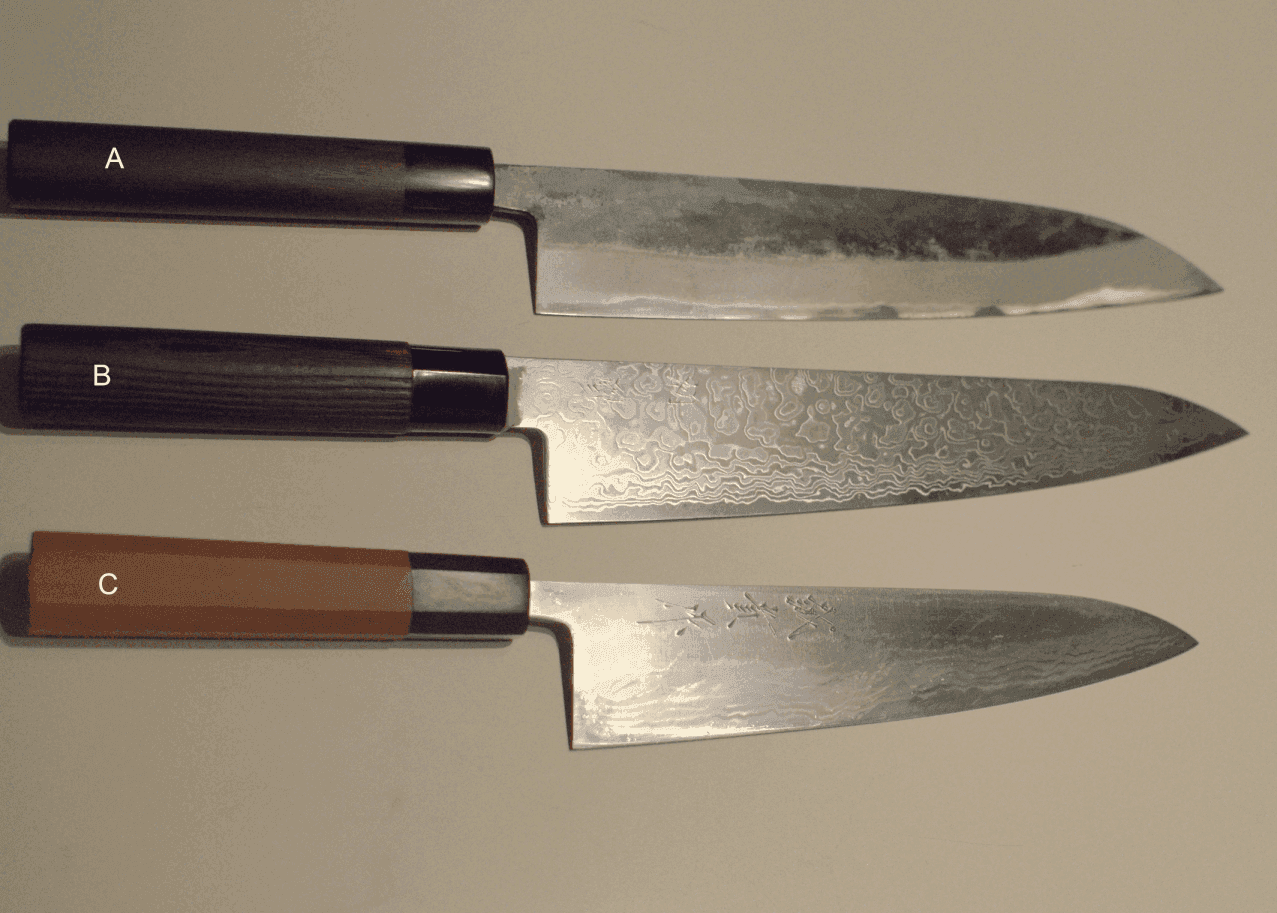
- A) is a kurouchi cladding. The bottom is the exposed edge, the kurouchi is at the top near the spine. In between is hazy looking kasumi finish.
- B) is a soft stainless cladding with a Damascus pattern.
- C) is also Damascus, but a reactive iron cladding which is much more pleasant to sharpen than stainless cladding.
6. HANDLES
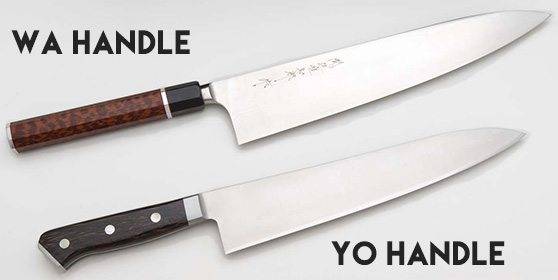
Handle options are classified as either the western style (yo handle) or the wooden japanese handle (wa handle). Western handled knives will typically be more ‘balanced’ in weight and also heavier overall. Wa handled knives are lighter and usually blade heavy. I actually like a blade heavy knife because it helps with cutting. You might not think a few ounces here or there matter, but it can add fatigue over time.
Wa handles have some other advantages. They are easier to replace and it seems to me that the blades can be thinner.
Finally, and sorry lefties, another restriction: western, octagon, or oval handles can be used by lefties and righties alike, but D shaped handles are made one way or the other.
7. LENGTH
It’s baffling, but I hear a lot of people justify their knife length decisions by their height. “I’m 6’3 so I need a 12” knife!”. Personally, I would rather choose by these criteria:
- The size of your cutting board and workspace. If you have no elbow room and a short board, don’t pick up a longer gyuto.
- The size of your product. If you normally work with big items like watermelon or even a cabbage, you’ll find 210mm is a bit short.
Japanese knives are pretty much always listed in increments of 30mm. Some are oversized, some are undersized from that number though. You should also check if it is being measured from the handle to the tip or just the cutting edge from the heel to the tip. Generally, western handled knives are always measured along the edge, heel to tip. The rules for wa handled knives are trickier, so I would ask the vendor about that particular knife.
I use a 240mm at home most of the time. I have longer and shorter options, but that’s what I pick up the most. For prep cooks, if you have the space, 270mm is more efficient. The longer length will also help with edge retention since you’re using different areas along the edge. Some cooks have one for prep, and a shorter 210mm for use on the line where there’s less space.

MAINTENANCE TIPS
1. HONING
Food television stars will probably tell you “hone every time you take your knife out of the block” or something like this. That doesn’t even make sense for soft steeled french or german knives. On a soft steel, the edge can bend one way or the other when you hit a hard item or the cutting board. Honing re aligns this edge. Anything more than a few light strokes on the hone is counterproductive. Gordon Ramsay clips where he hones vigorously are good for tv, but not for your knife. It’s like a paper clip that you bend back and forth; too much will fatigue the steel and eventually it won’t hold an edge at all. Soft steel knives should be honed only when necessary.
Harder steeled gyutos should not be honed on a steel honing rod at all. Hard steels won’t bend and they don’t require honing. If they hit anything they shouldn’t like bone, they’ll chip before bending. With the additional steel hardness comes more brittleness. These types of knives do not agree with any lateral pressure, like from a honing rod, which can cause small chips. I cook at home, so I have other options for touch ups on the edge like stropping or fine grit waterstones. If you need a hone to carry in your knife roll, look for ceramic honing rod, like the Idahone and make sure to use light pressure.
2. SHARPENING
When sharpening an asymmetric knife, the angles will have to vary on each side if you want to follow the bevel already on there. I recommend using a marker on the bevel to make sure you’re abrading at the correct angle and not going too high or low and abrading away behind the edge. You could also look at the scratch pattern to see where your knife has been hitting the stone. This rules out pull through sharpeners which rip off chunks of steel, sharpening machines at fixed angles that are too obtuse, and the sketchy guy in a van with a belt sander. You should learn to freehand sharpen for yourself on waterstones or find someone who does.
3. MAINTAINING THE GEOMETRY

Forged knives are thicker at the spine than the edge, that’s just how it is. If you sharpen without thinning, your edge is going to move closer to the spine and your knife will get thicker. To maintain the intended geometry and performance of your knife, you need to take your knife to the stone at a very low angle to thin behind the edge. Some people let their knives get thick and do this thinning all at once; I prefer to thin a little bit with every sharpening. I like thinning my knives freehand on waterstones. You can always take more metal off, but you can’t put it back on. If your knife gets too thin, thinner than intended by the maker for this type of steel, hardness, etc. then the edge retention could suffer. For a gyuto, I just need it to cut potatoes and onions without wedging. If it can do that, I’ll stop there.
4. HANDLES
Nice wood handles need to be oiled with mineral oil, especially if they are raw, unfinished wood. I use a homemade board butter made from pharmaceutical grade mineral oil mixed with some food safe beeswax for water resistance. That same mixture is great for wooden cutting boards, salad bowls, and spoons too.

REVIEWS OF MY 4 FAVORITE GYUTOS
There are people out there that buy and sell knives just to try as many as they can. I’m more interested in cooking, so I get one that I like and stick to it mostly. Anyway, I’ve used a few japanese chef knives that I can comment on. In case you skipped the whole article above, what I like or don’t like is not as important as what you prefer.
GOKO SWEDISH STEEL (19C27) 240mm

Goko is mostly known for a white steel gyuto, but they made a couple runs of swedish stainless steel knives. It came with a chestnut handle with plastic ferrule (not my favorite). There was a hammered finish option that I missed out on. Mine is a stainless damascus cladding. My preferences have changed since I bought this knife, so I now find the stainless damascus pattern kind of tacky. Anyway, the knife itself is very very thin even with cladding. It is also surprisingly stiff for its thinness. I usually expect really thin knives to flex somewhat. It has a decent flat spot and a gentle curve towards the tip. This is pretty much my go to when I need laser thinness. It is knife B in the pictures above.
TANAKA DAMASCUS AOGAMI #2

Reactive carbon cladding over a carbon steel core. The cladding takes a very cool blue and purple patina. Right side looks convexed, left side flat. I bought mine used and thinned it just a little, and it really is an excellent cutter. I can’t tell how thick it was originally because maybe the previous owner sharpened without thinning. I think it’s a solid choice in this price range. This was knife C in the pictures above.
KAJIWARA 240mm BLUE #2

Really flat profile, kurouchi finish knife. This knife is thick at the spine (4mm or so), but decently thin behind the edge. I enjoy the flat profile a lot for push cutting. The Kajiwara is great for slicing if it’s already out and I don’t want to get a slicer dirty. Knife A in the pictures above.
SHUN ELITE 8” CHEF’S KNIFE
 Soft stainless clad VG-10 knife. I sharpened this for my friend and it had a bunch of chips I had to remove. He admitted to poor technique, storage, and using a steel hone on it, which is probably a lot of that damage. I used the opportunity to play around with it. The Shun was just not for me. It’s too short, and there’s too much belly. I don’t rock chop so it doesn’t work for my techniques. Decent grind and fit and finish, I just don’t care for the profile and VG-10 doesn’t excite me.
Soft stainless clad VG-10 knife. I sharpened this for my friend and it had a bunch of chips I had to remove. He admitted to poor technique, storage, and using a steel hone on it, which is probably a lot of that damage. I used the opportunity to play around with it. The Shun was just not for me. It’s too short, and there’s too much belly. I don’t rock chop so it doesn’t work for my techniques. Decent grind and fit and finish, I just don’t care for the profile and VG-10 doesn’t excite me.
YOUR TURN
It’s now up to you to choose the right gyuto for your needs, and I hope my recommendations will help you. Let me know if you have questions leaving a comment below.









